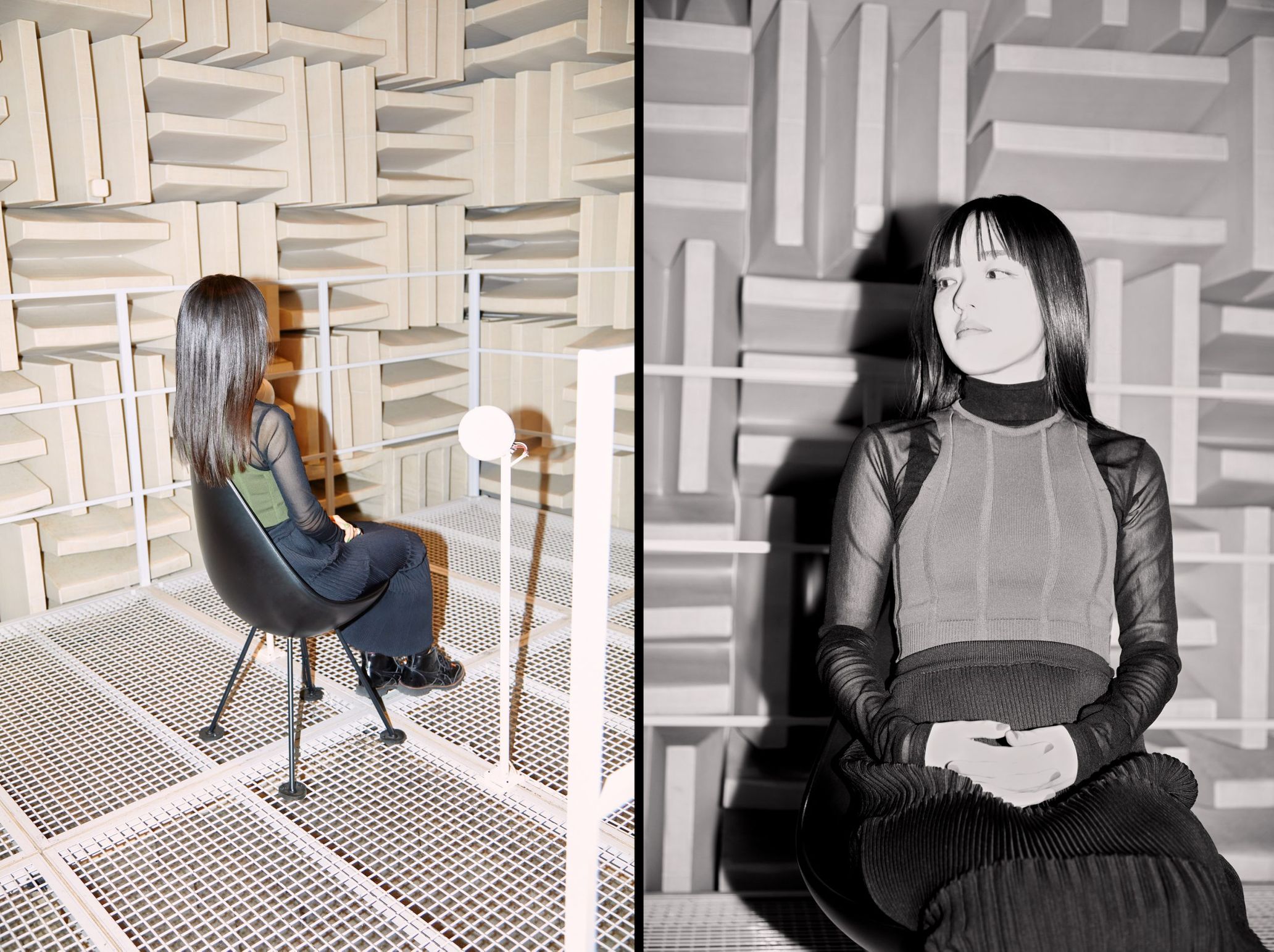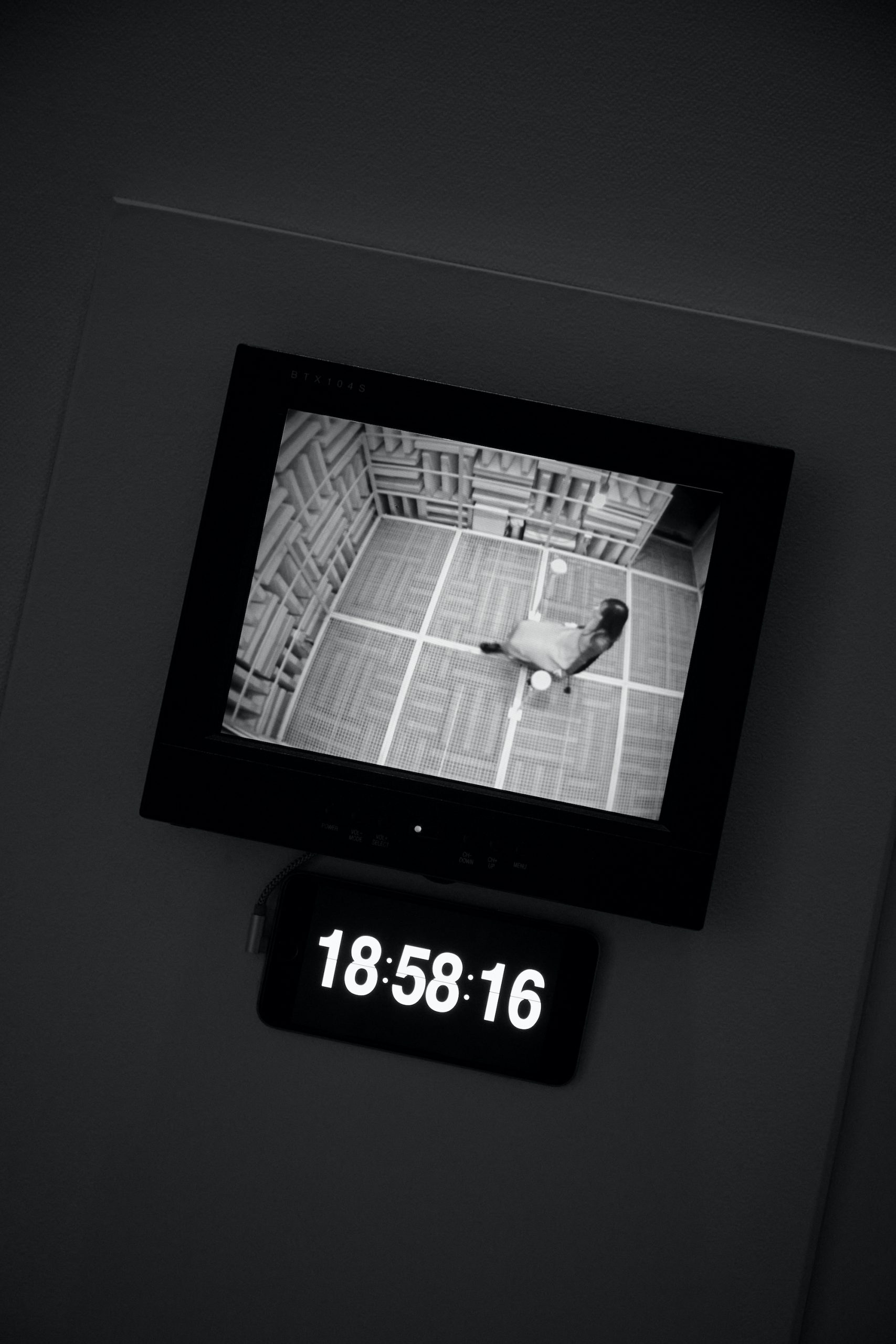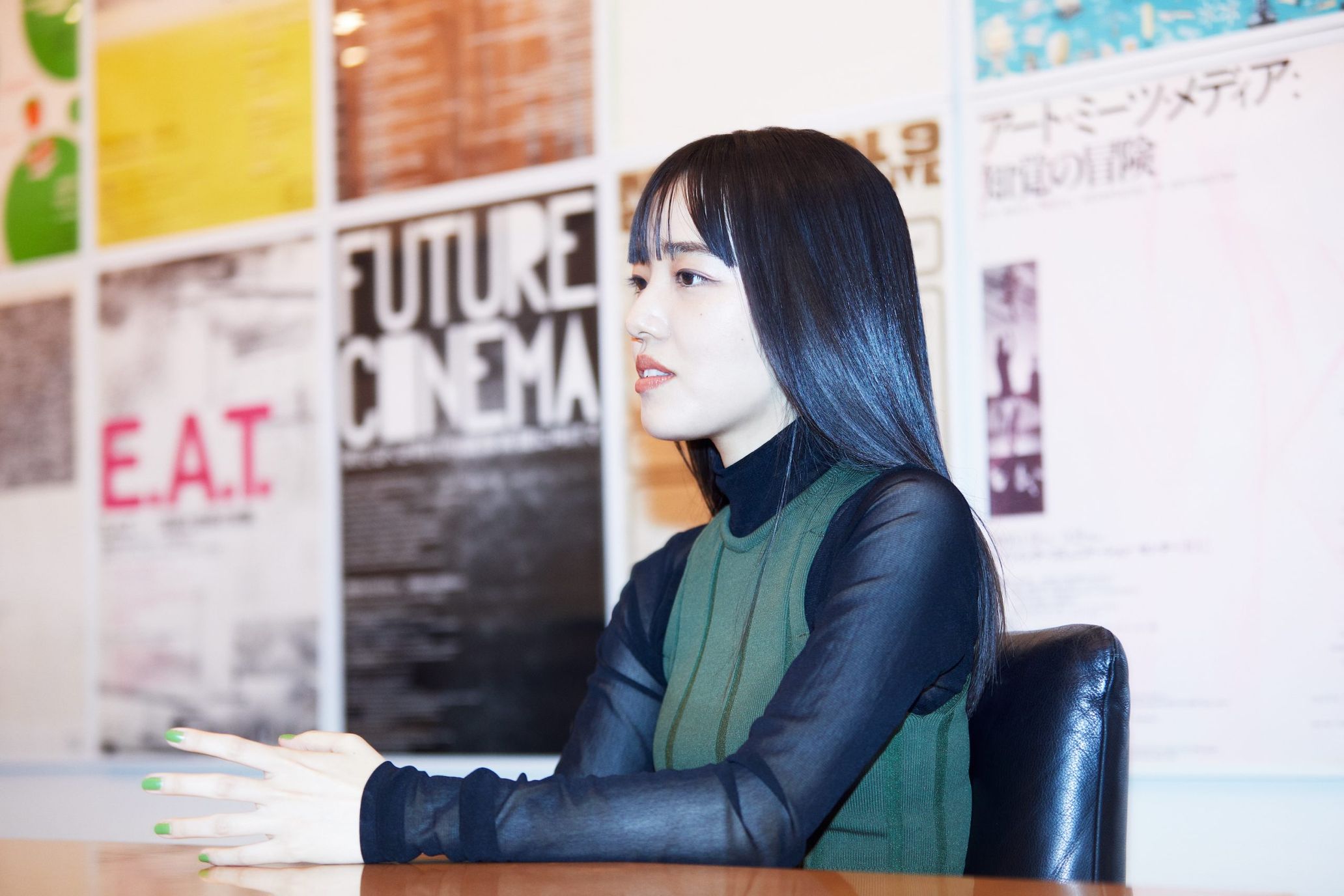Sound artist Miyu Hosoi’s works range from multi-channel sound installations, stage performances, and multitrack recordings. She has presented Lenna, an experimental sound installation created with 22.2 surround channel format at NTT ICC Anechoic Room, YCAM, Sapporo SCARATS, and Tokyo Metropolitan Theatre Concert Hall. In 2019, she presented sound mine, a newly composed concert by Miyu Hosoi + Shun Ishiwaka + YCAM at YCAM, and last year she exhibited Crowd Cloud (co-creation with Yuri Suzuki) curated by Paola Antonelli, curator of MoMA, at Tokyo International Haneda Airport. We interviewed this internationally acclaimed sound artist about the origin of her creation and the relationship between sound and space.
Voice as a material: Self-pride as a sound artist
–First of all, could you tell us about how you created Lenna, the 22.2ch surround system exhibited at the NTT ICC Anechoic Room?
Miyu Hosoi: 22.2ch is available to the public as a surround sound format that allows for a free form of sound expression, although it is difficult for creators to access it. The only people who have access to it are major artists or those who have their own studios, and I don’t like the fact that the environment for creating and listening to music with it is not well prepared. I was frustrated by the fact that I couldn’t express myself with 22.2ch if I have no access to it through the connection with limited number of prestigious people. I tried my hand at making my own music with Lenna, and I consider it my first work as an artist.
–Do you have a desire to defy the boundaries of expression by creating your own work?
Hosoi: I scarcely create works for positive reasons. I’m motivated by the desire to overturn what the world thinks is impossible.
— You seem to regard “voice” as a tool to bring awareness to the space. Is that right?
Hosoi: For me, “voice” is like a tool for sound sources. Just like the piano, I can do it by myself. On the other hand, there are works where I don’t use the voice at all. The next performance, which I’m going to do on a deserted island in Yokosuka, will be a work that doesn’t use voices or speakers, but just explores the acoustic environment.
— For a musician who has a background in choral music, it does not seem to be very common to think of using your voice as a material to expand the environment just as you did in Lenna, rather than squarely dealing with it. Could you please explain how you came to think of it that way?
Hosoi: Chikara Kamizutaru composed the music for Lenna, while I was in charge of recording and voice. We also have a team of engineers: Misaki Hasuo, who creates the sound movement and the whole experience of the work, Toshihiko Kasai, who controls the beauty of the work, and Jiro Kubo, who is the system engineer for the 3D sound. I feel that I am creating the work from a producer’s standpoint.
22.2ch is a format developed by NHK, but Lenna is released under Creative Commons, so I regard the fact that the work is distributed as an example of work for this format and the secondary use is allowed as one kind of accomplishment. I think the next phase of my creative process, which began with frustration, has finally come into view after two years of work.
The key for increasing the intensity of my own expression: Self-consciousness of being background role and the perception of space as an instrument
–As a sound artist, why do you focus on space?
Hosoi: In the discipline of acoustic architecture, there is an area called concert hall design. As Yasuhisa Toyota of Nagata Acoustics Design said, “A hall is a musical instrument.” As can be attested to by him, it is important for me to be aware of not only the sound itself, but also the place where it is played and the place where it is heard. Since he was involved in the supervision of my project before, I have become very attached to the space. For example, in this conference room, the ceiling is rounded off. When you clap your hands, it makes a strange sound.
If the final output of the work was done on a computer, I think I could notice something before the work was presented, since I use the computer in the creation process as well. However, in the case of an installation, even in a vast space of a museum, for example, the way the sound reverberates is completely different depending on which part of the space the listeners are in. There are a variety of things to consider in terms of how to exhibit the work in a museum, including the distance between viewers and the exhibited works. In the exhibition of artworks, there is a process of creating the artwork and then installing it in the space. We also have to design an experience for visitors to approach the work, so the realm of expression is much broader than just recording and releasing music.
–In addition to your solo works, you now have more and more collaborative works, such as (((||| and Crowd Cloud curated by Paola Antonelli, the curator of MoMA at Tokyo International Haneda Airport. Can you tell us the difference between individual production and collaboration?
Hosoi: It’s difficult to know how much to leave to others and how much to take as your own responsibility. For example, if the pre-established disharmony born out of my abstract order turns out badly, I feel the way I asked for was wrong. I don’t want to give up my commitment, which is a kind of my pride as a musician. It would be rude to say “That’s not something I was expected” later.
–I think it’s also an issue of your fluctuated standpoint which is in between the status as a backstage supervisor and the artist. What do you think?
Hosoi: It’s true that I like to take a background role these days. Mentally, I feel like I’m moving forward if I working in that way, and it would be hard if I didn’t have time to constantly input. For example, I think it’s more efficient if I understand the place I am working in, because I can move as one of the workers. I feel a little embarrassed that I have never constructed any soundproofing material even though I am working on a sound installation. Haha. It’s often better to look at the work from a producer’s point of view, even though I am an artist. For this year’s exhibition, I will be working with a team of people who have constructed several of my works in the past and are now training me.
–What exactly is going when you take a background role?
Hosoi: I was allowed to accompany the “Super Factory” that set up the Crowd Cloud in Haneda Airport, and they taught me everything from how to build walls to how to apply putty. The more you understand about where you are working in through your work, the more you can build a relationship with them.
–I am impressed that you go that far.
Hosoi: It’s faster to understand what kind of material and how much effect it will have if you work with your hands. The artist’s hands are often free after he/she explained the concept. In doing so, you can show your respect to the construction workers, and I believe the work of art will become more convincing.
–Do you mean an intensity as an artist by that, don’t you?
Hosoi: As long as I am presenting my work, I think I need to be able to have a discussion about my expression, just as Seiko Mikami and Dumb Type did. On the other hand, it is true that there are still parts that cannot be fully explained in words, but the context is important. Since artists express themselves in ways that can only be verbalized in their works, they cannot make irresponsible comments on their works. There is a specific form of artist team that I admire, and I would like to get closer to that.
–At the same time, you are releasing your music and works on the Internet. What do you think is the meaning of releasing recordings of sound that can only be experienced at the exhibition venue through the internet?
Hosoi: For example, a high school girl happens to listen to 22.2ch binaural sound online, and from there she accesses my work and comes to see my exhibition. I believe the benefits of this possibility outweigh the negatives of uploading my work to the Internet.
–Listening to your answers about the value of the relationship between the listeners and the artist, I think you seem to release your work as if leaving a work behind in the world. Am I right?
Hosoi: That’s right. I start to think about what to do next at the time when I release my work. Even if I get negative feedback on my work, it’s something about myself in the past, but it’s a different issue for me now. I don’t want to follow up on my old self.
–How do you want to pursue your expression in the future?
Hosoi: I think my area of activity is unique, so it would be good if maniacs could come to my exhibitions, and I want to continue to express myself in a way that is properly conveyed. Even if I widen the door, what I want to do is actually maniacal. That’s because I’ve always wanted to disappoint people’s expectations. I feel that if someone expects something from me, it means that I am still in their imagination. In that sense, I try to keep a distance from situations where someone expects something from me. However, rather than the expectation for the work itself, I would like to honestly and happily accept expectations from people in terms of my way of thinking and my slightly peculiar intentionality.
Miyu Hosoi
She was exposed to contemporary music through choral singing in high school, and has participated in numerous compositions, live performances, and sound installations since she was a student at Keio University. In 2019, her 22.2-channel work Lenna was presented at the ICC Anechoic Room, the Yamaguchi Center for Arts and Media (YCAM), the Sapporo Center for Arts and Culture (SCARTS), the Tokyo Metropolitan Art Space Concert Hall, and the Acoustical Engineering Society International (AES). In the same year, she released her first full-length album, Orb, on the label Salvaged Tapes, which consisted entirely of her own voice, including Lenna. Her recent works include Crowd Cloud, a collaborative performance with sound artist Yuri Suzuki presented in February 2021. And she will be presenting a new sound installation at Sarushima, an uninhabited island in Yokosuka, in January 2022. She is participating in the Open Space, an exhibition at ICC until February 27, 2022, which features media art works and other diverse expressions in the contemporary media environment.
Official website: https://miyuhosoi.com/
Instagram: @miyuhosoi
Twitter: @miyuhosoi
■Open Space Exhibition
Period: until February 27, 2022
Venue: NTT Inter Communication Center (ICC)
Address: Tokyo Opera City Tower 4F, 3-20-2 Nishi-Shinjuku, Shinjuku-ku, Tokyo
Opening hours: 11:00 – 18:00
Holidays: Mondays (the following day if Monday is a national holiday or a substitute holiday), year-end and New Year holidays (December 27 – January 4), maintenance day (February 13)
Admission: Free (advance reservation required; priority given to those with advance reservations on the day of admission)
Web site: Open Space 2021 New Flatland
Photography RiE amano
Edit Jun Ashizawa(TOKION)
Translation Shinichiro Sato(TOKION)






